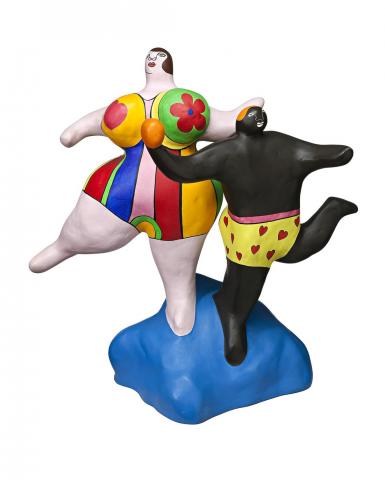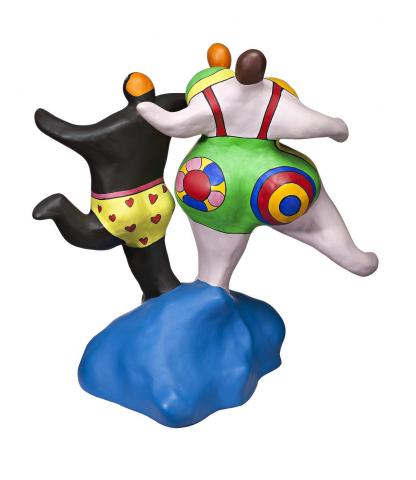LES BAIGNEURS, 1980 – 81
NIKI DE SAINT PHALLE
painted polyester resin
47.0 x 47.0 x 30.5 cm
edition: 7/20, aside from the edition of 150
signed and numbered on base: Niki / VII/XX
stamped on base with Plastiques d'Art R. Haligon foundry mark
Galerie Samy Kinge, Paris
Private collection, California
Private collection, Melbourne
Les Baigneurs, 1980 – 81, vinyl paint and polyester, 51.0 x 48.0 x 35.0 cm, Yoko Shizue Masuda Collection, Japan, illus. in Morineau C., and Yamada Y., Niki De Saint Phalle, National Art Centre Tokyo, Tokyo, 2015, cat. 065, p. 99
As High Priestess of her own idiosyncratic, mythological world – Niki de Saint Phalle has created a universal vocabulary that enables her to address the challenges of contemporary society with tenderness, playfulness, passion and mystery.
Striking and naïve, Niki de Saint Phalle’s sculptures are instantly recognisable and easily bring joy to those who bask in their presence. A French-American painter, sculptor and film-maker, she had a long and unquiet presence in the male dominated avant-garde movements of post-war Europe and America. A self-taught artist, this rebellious outsider became a well-known figure within the French group of Nouveau Réalisme through her visceral tir paintings (in which she used a shotgun to explode bags of paint over sculptures and canvases), images of which were quickly disseminated around the world.
The French Nouveau Réalisme movement of the 1960s sought a greater connection between art and reality, re-establishing contact with society through a poetic appropriation of popular images, a process that had more in common with Dadaist thought than with the concurrent American Pop-Art movement. For Saint Phalle, this idea of a heightened link between art and society was most manifest in her Nana sculptures which addressed the role of women and reappropriated a derogatory French word for young women (i.e. gals, chicks, babes). As a group, the nanas constitute Niki de Saint Phalle’s most iconic and celebrated works.
In Les Baigneurs, 1980 – 81, the nana and her male companion balance on their tip toes, unpretentiously frolicking in a small corner of the deep blue sea. Taking many shapes and forms, the nanas are a tribe of archetypal females, celebratory vehicles for female power – embodying a victorious rebirth after the catharsis of Saint Phalle’s tir paintings. In a letter to the Swedish curator Pontus Hulten, the artist described her intention: ‘I wanted to invent a new mother, a mother goddess, and in these forms be reborn’.1 Harbingers of the women’s liberation movement, the nanas anticipated many of the major feminist issues of 1970s, including the representation of female sexuality, the image of the great goddess and a politicisation of female modes of decoration.2 While initially created with assemblages of fabric, wire mesh, hair and plastic found objects, the discovery of the polymer material, polyester enabled the artist to execute her nanas on a much larger scale and in multiple editions.
The couple was a recurrent theme in Saint Phalle’s work, stimulated by her artistic and emotional partnership with Swiss kinetic artist Jean Tinguely, whom she later married. The artworks exploring this theme restored balance between her all-powerful female goddess and various male companions – presenting the pairs in harmonious interaction (although often with a slightly larger Nana).
These taboo-breaking, assertive females presented a bold and buoyant representation of women. Large, frolicking and emblazoned with bold patterns and symbols from Saint Phalle’s own personal iconography (hearts, flowers, concentric circles, serpents etc.), they are Earth Mothers. The gay patterns that envelop the nana’s voluptuous forms are not intended to clothe the figures, they are rather the very skin of her goddesses. The highly feminine decorative element of Saint Phalle’s work exalted historical and domestic modes of expression for women, particularly craft and needlework, elevating them to the realm of high art.
This is the first work of Saint Phalle’s to be offered in Australia. In 2012, a monumental version of Les Baigneurs was temporarily installed on Park Avenue in New York, and throughout 2015, a major retrospective exhibition of her work toured the Guggenheim, Bilbao and the Grand Palais in Paris.
1. The artist in a letter to Pontus Hulten, Niki de Saint Phalle, exhibition catalogue, Kunst und Ausstellungshalle der Bundesrepublik, Germany, 1992 – 3, p. 15
2. Johnston, J. (et. al), Niki de Saint Phalle and the Tarot Garden, Acantos Benteli, Germany, 2010, p. 77
LUCIE REEVES-SMITH

